Chapter 6. Non-Parenteral Medication Administration
6.4 Administering Medications Rectally and Vaginally
Medication Administered Rectally
 |
 |
The rectal route (see Figure 6.8) is not as reliable in terms of absorption and distribution as oral and parenteral routes. The rectal route is, however, relatively safe because there is less potential for adverse effects (Perry et al., 2018). Rectal medications are given for their local effects in the gastrointestinal system (e.g., laxatives) or their systemic effects (e.g., analgesics when oral route is contraindicated). Rectal medications are contraindicated in persons with active rectal bleeding, diarrhea, recent rectal or prostate surgery, local trauma and those with undiagnosed GI disturbances (Martindale Pharma, n.d.). They are contraindicated in persons with cardiac arrhythmias because they can stimulate the vagus nerve causing cardiac arrhythmias (Perry et al., 2018). Suppositories cannot be cut to divide a dose because the drug is not distributed evenly throughout the suppository (Burcham & Rosenthal, as cited in Perry et al., 2018). Water-soluble lubricants or water can be used for lubrication to ease insertion into the rectum. Petroleum products can interfere with medication absorption (Munden, 2007) and as such should not be used.
Checklist 47 outlines the procedure for administering rectal suppositories or enemas.
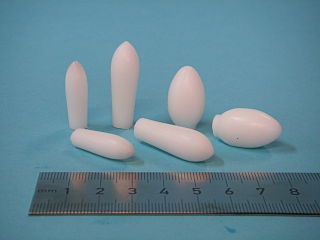
Checklist 47: Medication Administered RectallyDisclaimer: Always review and follow your agency policy regarding this specific skill. |
|||
Safety considerations:
|
|||
Steps |
Additional Information |
||
| 1. Perform hand hygiene before medication preparation.
Check MAR to guide you to which medications you are preparing. Follow agency policy to ensure MARs are accurate and verified appropriately. |
 An MAR that is checked by more than one healthcare professional provides a very reliable record for administering medications. Agencies may vary in relation to MAR verification processes. |
||
2. a. As you are removing medications from the dispensing system, perform the SEVEN rights three times with each individual medication (single dose packaging is not opened at this time):
|
The right patient: Check that you have the correct patient using two patient identifiers (e.g., name and date of birth).
The right medication (drug): Check that you have the correct medication and that it is appropriate for the patient in the current context. The right dose: Check that the dose makes sense for the age, size, and condition of the patient. Different dosages may be indicated for different conditions. The right route: Check that the route is appropriate for the patient’s current condition. The right time: Adhere to the prescribed dose and schedule. The right reason: Check that the patient is receiving the medication for the appropriate reason. The right documentation: Always verify any unclear or inaccurate documentation prior to administering medications. 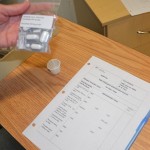 |
||
2 b. The label on the medication must be checked for name, dose, and route, and compared with the MAR at three different times:
|
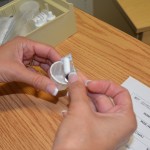 These checks are done before administering the medication to your patient. |
||
| 3. If possible, have patient defecate prior to rectal medication administration. | Medication should not be inserted into feces. | ||
| 4. Ensure that you have water-soluble lubricant available for medication administration. | Lubricant reduces friction as suppository enters rectal canal. Petroleum based lubricants can interfere with medication absorption. | ||
| 5. Explain the procedure to the patient. If patient prefers to self-administer the suppository/enema, give specific instructions to patient on correct procedure. | Patient may feel more comfortable self-administering suppository. If so provide glove, lubricant, and instructions. | ||
6. Raise bed to working height.
|
Positioning helps prevent injury to nurse administering medication. This protects patient’s privacy and facilitates relaxation.
Some literature suggests that left side-lying Sims’ position lessens the likelihood of the suppository being expelled. Drape protects linens from potential fecal drainage. |
||
| 7. Apply clean, non-sterile gloves. | Gloves protect the nurse from contact with mucous membranes and body fluids.
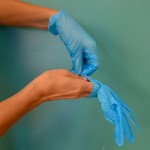 |
||
| 8. Examine the anal area for signs of hemorrhoids, rectal bleeding. | If hemorrhoids are present, use extra lubricant to minimize trauma. Suppositories are contraindicated in persons with rectal bleeding. If necessary, remove and reapply clean gloves. | ||
| 9. Remove wrapper from suppository/tip of enema and lubricate rounded tip of suppository and index finger of dominant hand with lubricant.
If enema, lubricate only tip of enema. |
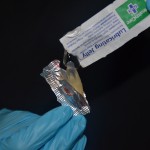 Lubricant reduces friction as suppository/enema enters rectal canal. Inserting the rounded top promotes patient comfort. |
||
| 10. Separate buttocks with non-dominant hand and, using gloved index finger of dominant hand, insert suppository (rounded tip toward patient) into rectum toward umbilicus while having patient take a deep breath, exhale through the mouth, and relax anal sphincter.
If enema: Expel air from enema and then insert tip of enema into rectum toward umbilicus while having patient take a deep breath, exhale through the mouth, and relax anal sphincter. |
Ensure the suppository is removed from the package. Upon insertion, you should feel the anal sphincter close around your finger. Forcing the suppository/enema through a clenched sphincter will cause pain. |
||
| 11. With your gloved finger, insert suppository along wall of rectum about 5 cm beyond anal sphincter. Do not insert the suppository into feces.
If enema: Roll plastic bottle from bottom to tip until all solution has entered rectum and colon. |
Suppository should be against rectal mucosa for absorption and therapeutic action. Inserting suppository into feces will decrease its effectiveness.
If the patient experiences cramping during enema administration, stop. Ask the patient to take a deep breath. Resume administration when cramps subside. Hold buttock cheeks together if patient feels immediate need for BM. |
||
| 12. Option: A suppository may be given through a colostomy (not ileostomy) if prescribed. | The patient should lie supine and a small amount of lubricant should be used. | ||
| 13. Remove finger and wipe patient’s anal area. | Wiping removes excess lubricant and provides comfort to the patient. | ||
| 14. Ask patient to remain on side for 5 to 10 minutes. | This position helps prevent the expulsion of suppository. | ||
| 15. Discard gloves by turning them inside out and disposing of them and any used supplies as per agency policy. Perform hand hygiene. | Using gloves reduces transfer of microorganisms.
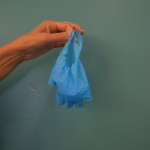 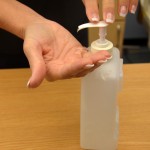 |
||
| 16. Ensure call bell is nearby and bedpan or commode is available and close by. | If suppository is a laxative or stool softener, patient will require a bedpan/commode or close proximity to toilet.
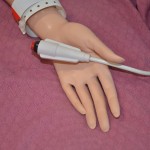 |
||
| 17. Document procedure as per agency policy and include patient’s tolerance of administration. | Timely and accurate documentation promotes patient safety. | ||
| Data sources: BCIT, 2015; Lilley et al., 2016; Perry et al., 2018 | |||
Medication Administered Vaginally
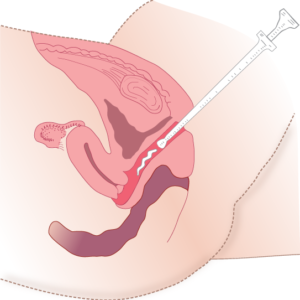 |
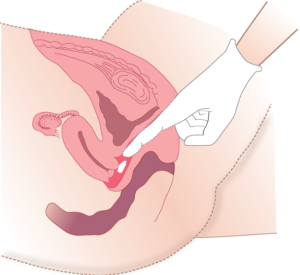 |
Female patients may require medications vaginally to treat vaginal infections. This may include suppositories, foams, and or creams. Vaginal suppositories are larger and more oval than rectal suppositories, and are inserted with an applicator (see Figure 6.11) or by hand (see Figure 6.12). Checklist 48 outlines the procedure for administering vaginal suppositories or medications.
Checklist 48: Medication Administered VaginallyDisclaimer: Always review and follow your agency policy regarding this specific skill. |
||||
Safety considerations:
|
||||
Steps |
Additional Information |
|||
| 1. Perform hand hygiene before medication preparation.
Check MAR to guide you to which medications you are preparing. Follow agency policy to ensure MARs are accurate and verified appropriately. |
 A MAR that is checked by more than one healthcare professional provides a very reliable record for administering medications. Agencies may vary in relation to MAR verification processes. |
|||
2 a. As you are removing medications from the dispensing system, perform the SEVEN rights three times with each individual medication (single dose packaging is not opened at this time):
|
The right patient: Check that you have the correct patient using two patient identifiers (e.g., name and date of birth).
The right medication (drug): Check that you have the correct medication and that it is appropriate for the patient in the current context. The right dose: Check that the dose makes sense for the age, size, and condition of the patient. Different dosages may be indicated for different conditions. The right route: Check that the route is appropriate for the patient’s current condition. The right time: Adhere to the prescribed dose and schedule. The right reason: Check that the patient is receiving the medication for the appropriate reason. The right documentation: Always verify any unclear or inaccurate documentation prior to administering medications.  |
|||
2 b. The label on the medication must be checked for name, dose, and route, and compared with the MAR at three different times:
|
 |
|||
| 4. Have patient void prior to procedure. | Voiding empties the bladder and promotes patient comfort. | |||
| 5. Before inserting the medication vaginally, explain the procedure to the patient. If patient prefers to self-administer the vaginal medication, give specific instructions to patient on correct procedure. | Patient may feel more comfortable self-administering vaginal medication. | |||
6. Raise bed to working height.
|
Position helps prevent injury to nurse administering medication.
Draping protects patient’s privacy and facilitates relaxation. |
|||
| 7. Apply clean, non-sterile gloves. Assess the vaginal area for discharge, ask about pruritis or burning discomfort. | Gloves protect the nurse from contact with mucous membranes and body fluids.
 |
|||
| 8. Remove suppository from wrapper and apply a liberal amount of water-soluble lubricant to suppository and index finger of dominant hand. Suppository should be at room temperature. | Lubricant reduces friction against vaginal mucosa as medication is inserted.
 |
|||
| 10. With non-dominant hand, gently separate labial folds. With gloved index finger of dominant hand, insert lubricated suppository about 8 to 10 cm along posterior vagina wall. | Exposes vaginal orifice and helps to ensure equal distribution of medication. | |||
| 11. Withdraw finger and wipe away excess lubricant. | Wiping maintains patient comfort. | |||
| Note: An applicator may be used to insert vaginal medication. Follow the procedure above and specific manufacturer directions. | ||||
| 12. Discard gloves by turning them inside out and disposing of them and any used supplies as per agency policy. Perform hand hygiene. |
  |
|||
| 13. Document procedure as per agency policy, and include patient’s tolerance of administration. | Timely and accurate documentation promotes patient safety. | |||
| Data sources: Lilley et al., 2016; Perry et al., 2018 | ||||
Critical Thinking Exercises
- Discuss the procedure for administering a suppository for someone with a colostomy.
- Your patient prefers to self-administer her vaginal suppository. Outline the steps you would explain for safe and appropriate administration of a vaginal medication.
Attributions
Figure 6.9. Diagram of the rectum and anus by Waterced is used under a CC BY-SA 4.0 International license.
Figure 6.10. Suppositories in three different sizes by Alcibiades is in the public domain.
Figure 6.11. Administering medication vaginally using an applicator by Mikael Haggstron is used under a Creative Commons Attribution-ShareAlike License
Figure 6.12. Administering medication vaginally without an applicator by Mikael Haggstron is used under a Creative Commons Attribution-ShareAlike License

